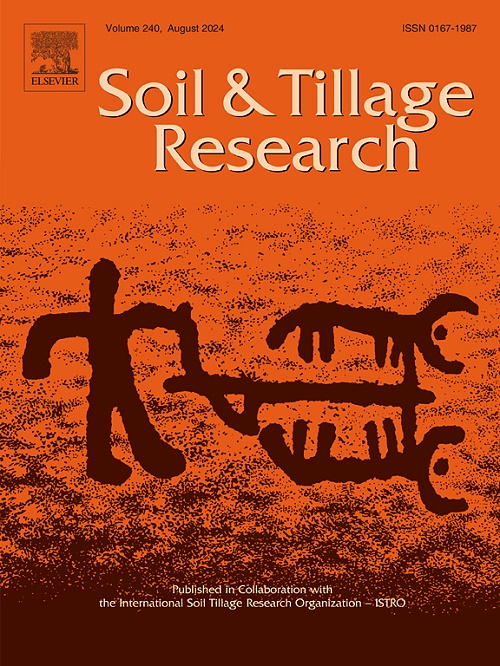Impact of tillage practices and arbuscular mycorrhizal fungi inoculation on organic sweet corn yield and nutritional quality
IF 6.1
1区 农林科学
Q1 SOIL SCIENCE
引用次数: 0
Abstract
The application of mycorrhizal biofertilizers in agriculture has demonstrated potential for improving crop yield and nutrition. However, their effectiveness across different tillage systems and under on-farm conditions remain underexplored. This two-year study evaluated the effects of tillage practices and supplemental arbuscular mycorrhizal fungi (AMF) inoculation on the yield and nutrient composition of organically grown sweet corn (Zea mays). The experiment followed a split-plot design with two tillage practices—full tillage (FT) and reduced tillage (RT)—and four AMF treatments: mock (control), native AMF community (NAT), Rhizophagus irregularis, and Funneliformis mosseae. Results showed that FT significantly increased fresh and dry ear yields compared to RT. AMF inoculation, particularly with R. irregularis, enhanced kernel phosphorus (P) and potassium (K) concentrations. Inoculation with R. irregularis and F. mosseae also increased kernel vitamin B6 and C levels. Tillage influenced amino acid composition, with leucine and phenylalanine concentrations being higher in FT, while tryptophan was greater in RT. Additionally, R. irregularis and F. mosseae inoculation increased aspartic acid and glycine concentrations, which play a role in scavenging reactive oxygen species (ROS), suggesting a potential role for AMF in enhancing crop stress resilience and nutritional quality. Despite these benefits, natural AMF colonization across treatments may have masked the full effects of supplemental inoculation, highlighting the complexity of evaluating AMF biofertilizers in field conditions. Overall, this study suggests that while the presence of native AMF complicates the assessment of exogenous inoculation, AMF biofertilizers have positive implications for enhancing nutrient density of sweet corn across tillage practices.
耕作方式和丛枝菌根真菌接种对有机甜玉米产量和营养品质的影响
菌根生物肥料在农业中的应用已显示出提高作物产量和营养的潜力。然而,它们在不同耕作制度和农场条件下的有效性仍未得到充分探索。本研究评价了不同耕作方式和补充丛枝菌根真菌(AMF)接种对有机甜玉米(Zea mays)产量和营养成分的影响。试验采用两种耕作方式(全耕和免耕)和四种AMF处理(模拟(对照)、原生AMF群落(NAT)、不规则根噬菌(Rhizophagus irregularis)和mosefuneliformis mosseae)的分畦设计。结果表明,与对照相比,接种AMF显著提高了鲜穗和干穗产量,尤其是不规则稻,提高了籽粒磷(P)和钾(K)浓度。接种不规则弧菌和苔藓弧菌也能提高果仁维生素B6和维生素C水平。耕作方式影响了作物的氨基酸组成,水稻叶中亮氨酸和苯丙氨酸的浓度较高,水稻叶中色氨酸的浓度较高。此外,接种鸢尾草和凤尾草增加了天冬氨酸和甘氨酸的浓度,这两种物质在清除活性氧(ROS)中起作用,表明AMF在提高作物抗逆性和营养品质方面可能发挥作用。尽管有这些好处,但AMF在不同处理间的自然定植可能掩盖了补充接种的全部效果,这突出了在田间条件下评估AMF生物肥料的复杂性。总体而言,本研究表明,虽然本地AMF的存在使外源接种评估复杂化,但AMF生物肥料对提高甜玉米的养分密度具有积极意义。
本文章由计算机程序翻译,如有差异,请以英文原文为准。
求助全文
约1分钟内获得全文
求助全文
来源期刊

Soil & Tillage Research
农林科学-土壤科学
CiteScore
13.00
自引率
6.20%
发文量
266
审稿时长
5 months
期刊介绍:
Soil & Tillage Research examines the physical, chemical and biological changes in the soil caused by tillage and field traffic. Manuscripts will be considered on aspects of soil science, physics, technology, mechanization and applied engineering for a sustainable balance among productivity, environmental quality and profitability. The following are examples of suitable topics within the scope of the journal of Soil and Tillage Research:
The agricultural and biosystems engineering associated with tillage (including no-tillage, reduced-tillage and direct drilling), irrigation and drainage, crops and crop rotations, fertilization, rehabilitation of mine spoils and processes used to modify soils. Soil change effects on establishment and yield of crops, growth of plants and roots, structure and erosion of soil, cycling of carbon and nutrients, greenhouse gas emissions, leaching, runoff and other processes that affect environmental quality. Characterization or modeling of tillage and field traffic responses, soil, climate, or topographic effects, soil deformation processes, tillage tools, traction devices, energy requirements, economics, surface and subsurface water quality effects, tillage effects on weed, pest and disease control, and their interactions.
 求助内容:
求助内容: 应助结果提醒方式:
应助结果提醒方式:


